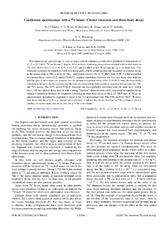| dc.creator | Charity, R. J. | |
| dc.creator | Wiser, T. D. | |
| dc.creator | Mercurio, K. | |
| dc.creator | Shane, R. | |
| dc.creator | Sobotka, L. G. | |
| dc.creator | Wuosmaa, A. H. | |
| dc.creator | Banu, A. | |
| dc.creator | Trache, L. | |
| dc.creator | Tribble, Robert E. | |
| dc.date.accessioned | 2011-09-13T21:25:42Z | |
| dc.date.available | 2011-09-13T21:25:42Z | |
| dc.date.issued | 2009 | |
| dc.identifier.citation | R. J. Charity, T. D. Wiser, K. Mercurio, R. Shane, L. G. Sobotka, A. H. Wuosmaa, A. Banu, L. Trache and Robert E. Tribble. Phys.Rev.C 80 024306 2009. "Copyright (2009) by the American Physical Society." | en |
| dc.identifier.uri | http://dx.doi.org/10.1103/PhysRevC.80.024306 | |
| dc.identifier.uri | https://hdl.handle.net/1969.1/127085 | |
| dc.description | Journals published by the American Physical Society can be found at http://publish.aps.org/ | en |
| dc.description.abstract | Resonance-decay spectroscopy is used to study particle-unbound excited states produced in interactions of E/A=10.7 MeV (10)C on Be and C targets. After inelastic scattering, structures associated with excited states in (10)C were observed at 5.22, 5.29, 6.55, 6.56, 6.57, and 8.4 MeV which decay into the 2p+2 alpha final state. This final state is created via a number of different decay paths, which include prompt and sequential two-proton decay to the ground state of (8)Be, alpha decay to (6)Be(g.s.), and proton decay to the 2.345-MeV state of (9)B. For the sequential two-proton decay states (5.22 and 6.55 MeV), angular correlations between the first two decay axes indicate that the spin of these states are nonzero. For the prompt two-proton decay of the 5.29-MeV state, the three-body correlations between the two protons and the core are intermediate between those measured for ground-state (6)Be and (45)Fe decays. The 6.55- and 6.57-MeV structures are most probably associated with the same level, which has a 14% two-proton decay branch with a strong "diproton" character and a 86% sequential two-proton decay branch. Correlations between the fragments following the three-body decay of the 2.345-MeV state of (9)B can be approximately described by sequential alpha decay to the (5)Li intermediate state. The 8.06- and 9.61-MeV (10)B states that decay into the d+(6)Li(2.186) channel are confirmed. Evidence for cluster structure in (13)N is obtained from a number of excited states that decay into the p+3 alpha exit channel. | en |
| dc.language.iso | en | |
| dc.publisher | American Physical Society | |
| dc.subject | R-MATRIX ANALYSIS | en |
| dc.subject | LIGHT-NUCLEI | en |
| dc.subject | ENERGY-LEVELS | en |
| dc.subject | SCATTERING | en |
| dc.subject | ISOTOPES | en |
| dc.subject | STATES | en |
| dc.subject | BE-6 | en |
| dc.subject | Physics | en |
| dc.title | Continuum spectroscopy with a (10)C beam: Cluster structure and three-body decay | en |
| dc.type | Article | en |
| local.department | Physics and Astronomy | en |


